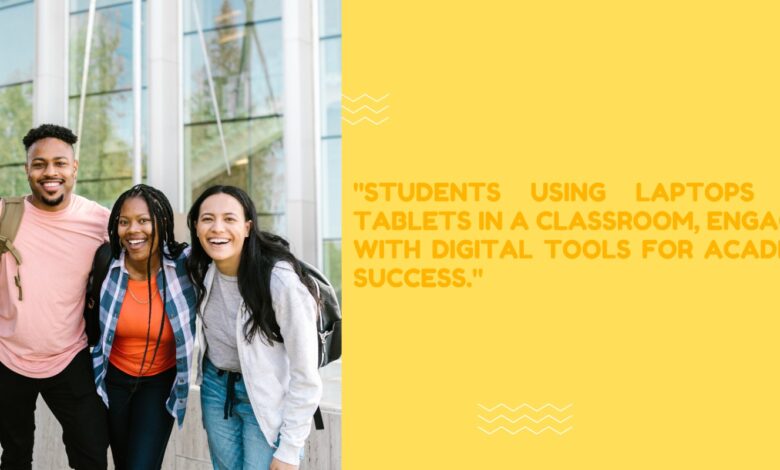Navigating the Digital Classroom: Harnessing Technology for Academic Success

Introduction:
In the dynamic landscape of modern education, the integration of technology has become more than just a trend; it’s a necessity. From traditional classrooms to virtual learning environments, the influence of digital tools is pervasive, fundamentally altering the dynamics of teaching and learning. In this digital era, where access to information is abundant, the demand for efficient educational resources, such as Assignment services, has surged.
Technology has revolutionized the way students interact with course materials, transforming once-static resources into dynamic and interactive platforms for learning. The evolution of e-learning platforms and mobile applications has redefined the boundaries of education, allowing students to access resources and support services like assignment help from anywhere in the world, at any time.
However, with these advancements come unique challenges. Issues such as the digital divide, where disparities in access to technology hinder some students’ ability to fully engage with online resources, remain prevalent. Moreover, ensuring the integrity and security of online academic assistance services, including assignment help platforms, is paramount to maintaining academic integrity.
In this article, we explore the symbiotic relationship between technology and education, focusing on how digital tools, including assignment help services, have become indispensable assets in the academic journey. We’ll delve into the benefits, challenges, and future implications of leveraging technology for educational support, emphasizing the importance of responsible integration and ethical use to foster academic success in the digital age.
1. The Evolution of Education Technology:
Over the decades, education technology, often referred to as EdTech, has undergone a remarkable evolution, reshaping the landscape of teaching and learning. Initially, technological interventions were limited, with tools like projectors and audio recordings marking the early stages. However, the digital revolution of the late 20th century brought about a seismic shift, paving the way for a plethora of innovations that have since become integral to modern education.
The emergence of the internet in the 1990s heralded a new era, allowing for the widespread dissemination of educational resources and facilitating global collaboration among students and educators. As online platforms proliferated, students gained access to a vast repository of information, while educators explored new avenues for delivering content and engaging learners.
Today, the educational technology ecosystem is multifaceted and dynamic, encompassing a wide range of tools and platforms designed to enhance the learning experience. From learning management systems (LMS) to interactive whiteboards and virtual reality simulations, the options are diverse and continually evolving.
Moreover, the demand for online academic assistance services, including platforms offering “Do My Assignments“ support, has surged in recent years. These services provide students with access to expert guidance and support, helping them navigate challenging coursework and achieve academic success.
In essence, the evolution of education technology has been characterized by innovation and adaptation, driven by the collective desire to improve educational outcomes and empower learners. As we continue to embrace emerging technologies and leverage online resources, the future of education holds boundless possibilities for collaboration, creativity, and personalized learning experiences.
2. Advantages of Technology in Education:
The integration of technology into education has unlocked a myriad of benefits, revolutionizing the learning experience for students and educators alike. One of the most significant advantages is the enhanced engagement fostered by interactive multimedia content and digital resources. Unlike traditional static materials, technology enables dynamic presentations, simulations, and interactive exercises that captivate students’ attention and promote active participation.
Furthermore, technology facilitates personalized learning, catering to individual student needs and learning styles. Adaptive learning platforms and educational apps analyze students’ performance and provide tailored recommendations and content, allowing for differentiated instruction and scaffolding of learning experiences.
Accessibility is another notable advantage of technology in education. Assistive technologies and accessibility features built into digital tools ensure that students with disabilities can fully participate in the learning process. Text-to-speech software, screen readers, and captioning tools are just a few examples of how technology removes barriers to learning for students with diverse needs.
Additionally, technology fosters global connectivity, enabling collaboration and cultural exchange among students worldwide. Video conferencing, online forums, and collaborative platforms facilitate communication and collaboration, breaking down geographical boundaries and fostering a sense of community among learners.
In summary, the advantages of technology in education are manifold, ranging from enhanced engagement and personalized learning to improved accessibility and global connectivity. By leveraging these benefits, educators can create dynamic and inclusive learning environments that empower students to succeed in the digital age.
3. Challenges and Solutions:
Despite the numerous advantages, the integration of technology into education also presents its fair share of challenges. One prominent issue is the digital divide, which refers to disparities in access to technology and internet connectivity among students, particularly those from low-income or rural communities. To address this challenge, initiatives such as providing subsidies for internet access and distributing devices to underserved students are crucial steps toward bridging the gap and ensuring equitable access to educational resources.
Another challenge is the need for technological literacy among educators. Many teachers may feel overwhelmed by the rapid pace of technological advancements and lack the necessary training to effectively integrate technology into their teaching practices. Professional development programs and ongoing training workshops can equip educators with the skills and confidence needed to leverage technology for enhanced learning experiences.
Cybersecurity concerns also pose a significant challenge in the digital classroom. Safeguarding student data and protecting privacy in online learning environments is paramount. Implementing robust security measures, such as encryption protocols and authentication procedures, can mitigate the risk of data breaches and unauthorized access to sensitive information.
Furthermore, there is a risk of overreliance on technology, where educators may prioritize digital tools at the expense of traditional teaching methods. Balancing the use of technology with offline activities and face-to-face interaction is essential to maintain a well-rounded educational experience.
By addressing these challenges through strategic initiatives and thoughtful implementation strategies, educators can harness the full potential of technology to create inclusive, engaging, and secure learning environments for all students.
4. Emerging Trends in Educational Technology:
As technology continues to evolve at a rapid pace, new trends in educational technology are constantly emerging, reshaping the way educators teach and students learn. One such trend is the integration of artificial intelligence (AI) into educational tools and platforms. AI-powered systems can analyze vast amounts of data to personalize learning experiences, provide adaptive feedback, and even create custom learning paths tailored to individual student needs.
Virtual reality (VR) and augmented reality (AR) are also gaining traction in education, offering immersive and interactive learning experiences. VR simulations allow students to explore virtual environments and conduct experiments in subjects like science and history, while AR overlays digital content onto the real world, enhancing understanding and engagement.
Blockchain technology is another emerging trend with potential applications in education. By providing secure and tamper-proof records of academic credentials and achievements, blockchain can streamline credential verification processes and reduce fraud in the education sector.
Additionally, the rise of mobile learning and microlearning reflects the increasing demand for flexible and bite-sized educational content that can be accessed anytime, anywhere, and on any device. Mobile apps and microlearning modules offer learners on-the-go access to relevant information and resources, facilitating continuous learning and skill development.
5. Strategies for Academic Success:
To achieve academic success in the digital age, students and educators can implement several effective strategies. First and foremost, fostering a growth mindset is essential, encouraging students to embrace challenges, learn from failures, and persist in the face of setbacks. Setting clear goals and developing a structured study plan helps students stay organized and focused on their academic objectives.
Utilizing technology wisely is another key strategy. Students can leverage digital tools and resources, including online tutorials, educational apps, and “do my assignments” services, to supplement their learning and seek assistance when needed. Additionally, practicing effective time management techniques, such as the Pomodoro Technique or the Eisenhower Matrix, can help students optimize their study sessions and balance academic commitments with other responsibilities.
Moreover, cultivating strong communication skills and building supportive relationships with peers and educators fosters collaboration, feedback exchange, and a sense of community, enhancing overall learning outcomes and academic success.
Conclusion:
In conclusion, the integration of technology into education presents boundless opportunities for academic advancement and innovation. While challenges such as the digital divide and cybersecurity concerns persist, strategic initiatives and ongoing professional development efforts can mitigate these obstacles. By embracing emerging trends like artificial intelligence and virtual reality, educators can create immersive and personalized learning experiences that cater to diverse student needs. Through effective strategies such as goal setting, time management, and fostering a growth mindset, students can navigate the digital landscape with confidence, ultimately achieving academic success and preparing for a future defined by continuous learning and adaptation.





Can you be more specific about the content of your article? After reading it, I still have some doubts. Hope you can help me.